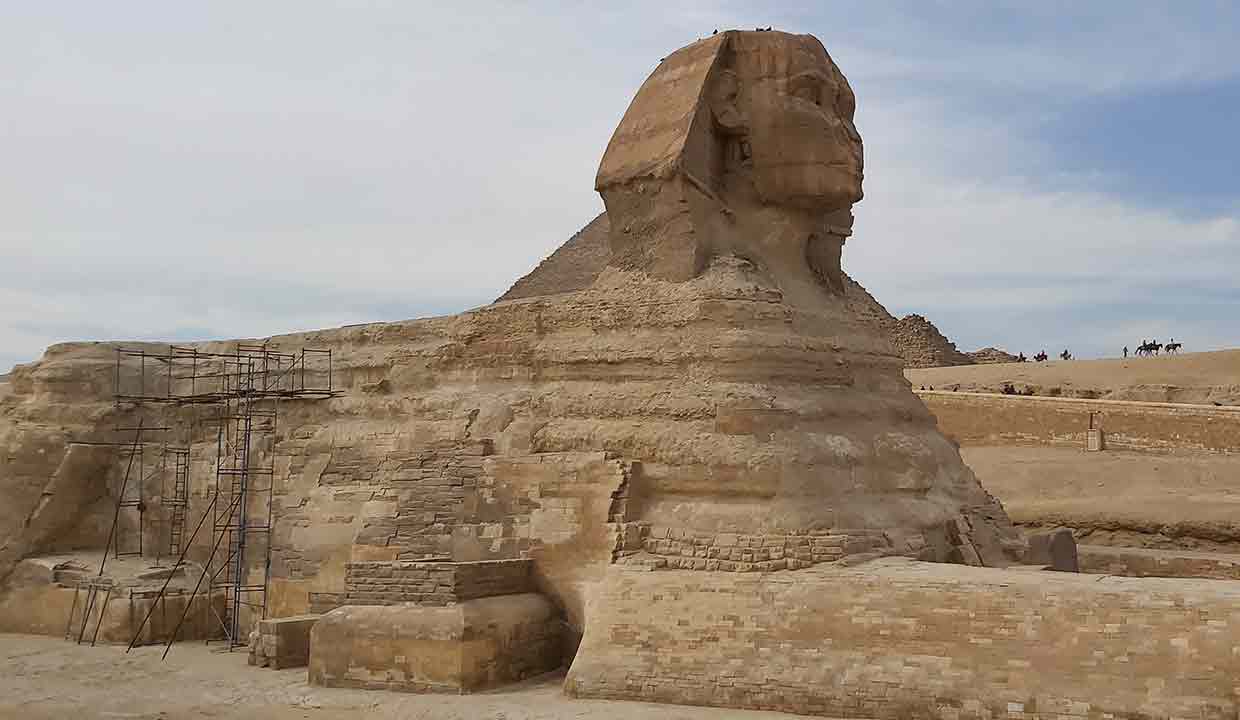Great Sphinx of Giza: Witness to Millennia and Celestial Cycles, Gazing eastward, the Great Sphinx beholds millennia, an emblem of Egypt’s undying legacy
One of the world’s most renowned and enigmatic symbols, the Great Sphinx of Giza, reigns supreme in the arid sands of Egypt, casting its gaze across millennia. The Sphinx, carved from the living bedrock of the Giza plateau, evokes wonder and curiosity in all who stand before its imposing presence. But what is it that makes this colossal statue so captivating? Let’s delve deeper into the realms of history, myth, and culture to unravel its tales.
Origins and Architecture
The Great Sphinx is carved out of a single ridge of limestone and stretches 73 meters (240 feet) in length and 20 meters (66 feet) in height. It’s an architectural marvel, especially when you consider that it was crafted using primitive tools around 4,500 years ago, during the reign of Pharaoh Khafre (also known as Chephren) in the Fourth Dynasty.
Its prominent human head, with discerning eyes and a half-smile, is adorned with a royal headdress, suggesting a Pharaoh’s likeness. This is widely believed to be the face of Pharaoh Khafre himself. The lion’s body, representing strength and courage, further adds to the statue’s grandeur.
Orientation and Significance
The Sphinx is meticulously positioned from west to east, greeting the rising sun. This is of immense significance in ancient Egyptian culture, where the sun was equated with rebirth and the eternal cycle of life and death. Ra, the sun god, played a central role in the Egyptian pantheon, and the Sphinx’s alignment might be a homage to him.
Its location on the Giza Plateau, in proximity to the pyramids, especially the Pyramid of Khafre, hints at its guardian-like role. As if it stands sentinel, the Sphinx seems to be guarding the pharaoh’s final resting place from malevolent forces, ensuring his journey to the afterlife is unhindered.
Erosion, Restoration, and The Riddle of Age
The Sphinx, being primarily limestone, is vulnerable to erosion. Over millennia, the unforgiving desert winds and occasional rains have taken a toll on its structure. There have been numerous restoration attempts, with some dating back to the time of the Pharaohs themselves.
One intriguing aspect that keeps both historians and enthusiasts rapt is the exact age of the Sphinx. While traditional Egyptology associates its construction with Pharaoh Khafre, there are theories suggesting it predates the Fourth Dynasty. Geological studies indicating water erosion patterns have fueled debates about the Sphinx being thousands of years older than previously thought.
Symbolism and Mythology
The Sphinx, a union of human intelligence and lion’s might, is a symbol of royalty and the divine power of the pharaohs. But its significance isn’t limited to Egyptian culture. Throughout history, the Sphinx has been a symbol of riddles, mystery, and wisdom. In Greek mythology, the Sphinx posed riddles to those who dared cross her path.
The Lost Nose and Cultural Vandalism
One of the most noted features, or rather the absence of it, is the Sphinx’s missing nose. While tales of Napoleon’s troops shooting it off with cannons are popular, they are inaccurate. Drawings from as early as the 18th century depict the Sphinx without its nose, predating Napoleon’s era. It’s believed that the nose was chiseled off, either due to religious reasons or sheer vandalism.
Conclusion
The Great Sphinx of Giza, with its blend of mythology, history, and architecture, continues to be an emblem of Egypt’s glorious past. It reminds us of an era where humans, amidst vast deserts, dreamt of eternity, and in their quest, carved wonders that would stand the test of time. The Sphinx, with its silent gaze, urges us to remember, question, and marvel at the tales of yesteryears.
